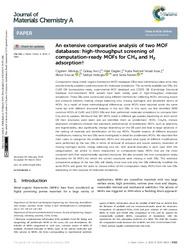An extensive comparative analysis of two MOF databases: high-throughput screening of computation-ready MOFs for CH4 and H2 adsorption
| dc.contributor.author | Altintas, C. | |
| dc.contributor.author | Avci, G. | |
| dc.contributor.author | Daglar, H. | |
| dc.contributor.author | Azar, A. N. V. | |
| dc.contributor.author | Fındıkçı, İlknur Eruçar | |
| dc.contributor.author | Velioglu, S. | |
| dc.contributor.author | Keskin, S. | |
| dc.date.accessioned | 2020-09-04T08:32:31Z | |
| dc.date.available | 2020-09-04T08:32:31Z | |
| dc.date.issued | 2019-04-28 | |
| dc.identifier.issn | 2050-7488 | en_US |
| dc.identifier.uri | http://hdl.handle.net/10679/6895 | |
| dc.identifier.uri | https://pubs.rsc.org/en/content/articlelanding/2019/ta/c9ta01378d#!divAbstract | |
| dc.description.abstract | Computation-ready metal-organic framework (MOF) databases (DBs) have tremendous value since they provide directly useable crystal structures for molecular simulations. The currently available two DBs, the CoRE DB (computation-ready, experimental MOF database) and CSDSS DB (Cambridge Structural Database non-disordered MOF subset) have been widely used in high-throughput molecular simulations. These DBs were constructed using different methods for collecting MOFs, removing bound and unbound solvents, treating charge balancing ions, missing hydrogens and disordered atoms of MOFs. As a result of these methodological differences, some MOFs were reported under the same name but with different structural features in the two DBs. In this work, we first identified 3490 common MOFs of CoRE and CSDSS DBs and then performed molecular simulations to compute their CH4 and H-2 uptakes. We found that 387 MOFs result in different gas uptakes depending on from which DB their structures were taken and we identified them as problematic' MOFs. CH4/H-2 mixture adsorption simulations showed that adsorbent performances of problematic MOFs, such as selectivity and regenerability, also significantly change depending on the DB used and lead to large variations in the ranking of materials and identification of the top MOFs. Possible reasons of different structure modifications made by the two DBs were investigated in detail for problematic MOFs. We described five main cases to categorize the problematic MOFs and discussed what types of different modifications were performed by the two DBs in terms of removal of unbound and bound solvents, treatment of missing hydrogen atoms, charge balancing ions etc. with several examples in each case. With this categorization, we aimed to direct researchers to computation-ready MOFs that are the most consistent with their experimentally reported structures. We also provided the new computation-ready structures for 54 MOFs for which the correct structures were missing in both DBs. This extensive comparative analysis of the two DBs will clearly show how and why the DBs differently modified the same MOFs and guide the users to choose either of the computation-ready MOFs from the two DBs depending on their purpose of molecular simulations. | en_US |
| dc.description.sponsorship | European Research Council (ERC) | |
| dc.language.iso | eng | en_US |
| dc.publisher | Royal Society of Chemistry | en_US |
| dc.relation.ispartof | Journal of Materials Chemistry A | |
| dc.rights | openAccess | |
| dc.title | An extensive comparative analysis of two MOF databases: high-throughput screening of computation-ready MOFs for CH4 and H2 adsorption | en_US |
| dc.type | Article | en_US |
| dc.description.version | Publisher version | en_US |
| dc.peerreviewed | yes | en_US |
| dc.publicationstatus | Published | en_US |
| dc.contributor.department | Özyeğin University | |
| dc.contributor.authorID | (ORCID 0000-0002-6059-6067 & YÖK ID 260094) Eruçar, İlknur | |
| dc.contributor.ozuauthor | Fındıkçı, İlknur Eruçar | |
| dc.identifier.volume | 7 | en_US |
| dc.identifier.issue | 16 | en_US |
| dc.identifier.startpage | 9593 | en_US |
| dc.identifier.endpage | 9608 | en_US |
| dc.identifier.wos | WOS:000467249200017 | |
| dc.identifier.doi | 10.1039/c9ta01378d | en_US |
| dc.identifier.scopus | SCOPUS:2-s2.0-85064448118 | |
| dc.contributor.authorFemale | 1 | |
| dc.relation.publicationcategory | Article - International Refereed Journal - Institution Academic Staff |
Files in this item
This item appears in the following Collection(s)
Share this page



